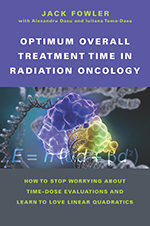
Optimum Overall Treatment Time in Radiation Oncology
Author: Jack Fowler with Alexandru Dasu and Iuliana Toma-DasuISBN: 9781930524736
Published: January 2015 | 93 pp | Softcover
Price: $ 40.00
Table of Contents
Optimum Overall Treatment Time in Radiation Oncology
Chapter 1: The Origins of Linear Quadratics
1.1 A 60+ Year Quest to Find How Fractionation Really Works, 1950 – 2014
1.2 The Linear Quadratic Concept and its Relevance to Clinically Sized Doses
in Radiotherapy
1.3 Time to Think
Chapter 2: LQ Modeling1.2 The Linear Quadratic Concept and its Relevance to Clinically Sized Doses
in Radiotherapy
1.3 Time to Think
2.1 The Simplest Modeling
2.2 The Seven Steps to Linear Quadratic Heaven: A Brief Summary
2.3 The Details
Chapter 3: Dose and Effectiveness2.2 The Seven Steps to Linear Quadratic Heaven: A Brief Summary
2.3 The Details
3.1 Biologically Effective Dose
3.2 Relative Effectiveness (RE)
3.3 Overall Treatment Time and Tolerances
3.3.1 Late Normal Tissue Complications
3.3.2 Acute Mucosal Tolerance
Chapter 4: Normalized Total Dose3.2 Relative Effectiveness (RE)
3.3 Overall Treatment Time and Tolerances
3.3.1 Late Normal Tissue Complications
3.3.2 Acute Mucosal Tolerance
4.1 Converting from BED to NTD or EQD
4.2 Gamma Slopes, the Standard of Prescription of Estimates of BED or NTD
4.3 How to Evaluate a New Schedule – a Summary
Chapter 5: A Review of Schedules4.2 Gamma Slopes, the Standard of Prescription of Estimates of BED or NTD
4.3 How to Evaluate a New Schedule – a Summary
5.1 Some of the Best-known Schedules
5.2 Standard Fractionation
5.3 Hyperfractionation
5.4 RTOG 90-03
5.5 Initially Too Hot in Table 5 – 1
5.6 General Considerations
5.7 The Danish Six Fractions a Week
5.8 Appropriateness of LQ Modeling
Chapter 6: How to Obtain Curves with Peaks of Optimum Overall Treatment Times5.2 Standard Fractionation
5.3 Hyperfractionation
5.4 RTOG 90-03
5.5 Initially Too Hot in Table 5 – 1
5.6 General Considerations
5.7 The Danish Six Fractions a Week
5.8 Appropriateness of LQ Modeling
6.1 Differences Between 7 Days and 3 – 4 Weeks in Tk
6.2 The Problem of Finding an Optimum Overall Time
Chapter 7: Time and Repopulation6.2 The Problem of Finding an Optimum Overall Time
7.1 Results vs Days of Overall Time
7.1.1 Two Fractions a Day Give More Tumor Log Cell Kill than One Fraction a Day
7.1.2 The Effect of Assuming Faster or Slower Repopulating Rates
7.2 Discussion: The Exceptional Cases of Very Fast Repopulation
Chapter 8: Should We Ever Use One Fraction a Day?7.1.1 Two Fractions a Day Give More Tumor Log Cell Kill than One Fraction a Day
7.1.2 The Effect of Assuming Faster or Slower Repopulating Rates
7.2 Discussion: The Exceptional Cases of Very Fast Repopulation
8.1 Discussion: Is One Fraction a Day Still to Be Used?
8.2 Main Conclusions
8.2.1 Conclusion #1: 2F/Day is Nearly Always Better than 1F/Day
8.2.2 Conclusion #2: Investigate Repopulation Rates for Use in Longer Schedules
8.3 Discussion: Smaller and Smaller Fractions
8.4 Discussion: How Long Is Really Too Long?
Chapter 9: How Short is Too Short?8.2 Main Conclusions
8.2.1 Conclusion #1: 2F/Day is Nearly Always Better than 1F/Day
8.2.2 Conclusion #2: Investigate Repopulation Rates for Use in Longer Schedules
8.3 Discussion: Smaller and Smaller Fractions
8.4 Discussion: How Long Is Really Too Long?
9.1 Introduction
9.2 Acute Tolerance Calculations Are Also Worth Doing
Chapter 10: Recovery9.2 Acute Tolerance Calculations Are Also Worth Doing
10.1 Incomplete Recovery
10.2 Incomplete Recovery as a Loss of Effect in Prolonged Fractions
Chapter 11: The Influence of Inter-patient Heterogeneity10.2 Incomplete Recovery as a Loss of Effect in Prolonged Fractions
11.1 Introduction
11.2 Tumor Control Probability Modeling
11.3 Results and Discussion
11.4 Summary
Chapter 12: Final Thoughts11.2 Tumor Control Probability Modeling
11.3 Results and Discussion
11.4 Summary
Photographs
Glossary
References and Additional Resources


